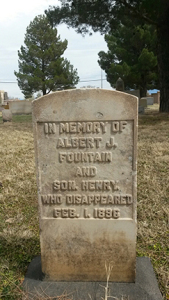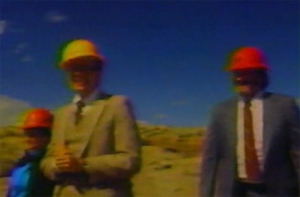David Lee Summers's Blog, page 93
December 26, 2016
Astronomers and Their Crypts
As we close out the year, I’m revisiting a couple of posts that I originally wrote for my Scarlet Order blog before I started posting exclusively here on the Web Journal. In the autumn of 2015, I wrote a post entitled “Haunted Observatories” and discussed how I got the inspiration for writing a ghost story set at an observatory.
As it turns out, I know of three observatories where astronomers are interred either at telescopes they helped to build or nearby. [image error] One is Percival Lowell, whose mausoleum is right outside the 24-inch telescope on Mars Hill in Flagstaff, Arizona. In the photo, you see my daughters and I standing beside his mausoleum. Another is James Lick, who funded the University of California’s Lick Observatory and is interred under the observatory’s 36-inch telescope. Also, John and Phoebe Brashear are interred under the Keeler Telescope at the Allegheny Observatory in Pittsburgh.
However, it’s not just bodies near telescopes that gave me the idea. My first job in astronomy was at Maria Mitchell Observatory on Nantucket Island. The building is an old-fashioned Gothic structure right next to the house once occupied by America’s first woman astronomer. My fellow research assistants and I would scare each other by telling stories of Maria’s ghost walking through the building. One night, one of my fellow research assistants even climbed on the roof while I was observing, made thumping noises, and sprayed Lysol in the dome to make me think I was smelling the perfume of Maria’s ghost. In a dark, cold dome in the middle of the night, it was pretty effective! This particular incident even inspired a scene in The Astronomer’s Crypt where one telescope operator scares another in a darkened hallway.
Even today, when I walk around the main floor at the base of the Mayall 4-meter telescope, I sometimes feel like I’m being watched. I look up to an alcove at a darkened stair landing shown in the photo to the right, where I think I see someone out of the corner of my eye. It always proves to be empty, and my skeptical mind always knows its just my mind playing tricks on me but every now and then, I wonder if a ghostly presence haunts the dome.
One astronomer was killed at the Mayall 4-meter almost thirty years ago in a tragic accident. Several people have died over the years on the twisting mountain road to the observatory, and a construction worker died while excavating the tunnel for the McMath-Pierce Solar telescope just across the mountain from the Mayall. There certainly is a potential for ghosts at the observatory.
I’ve only discovered one observatory that describes itself as haunted and that’s Perkins Observatory which was built for Ohio Wesleyan University, a small liberal arts college near Columbus. Ohio State University partnered with OWU to run the facility for a number of years, but finally terminated the relationship in 1998. The history page for the observatory tells us that the ghost of Hiram Perkins, the math and astronomy professor who founded the observatory, haunts the site out of frustration that he could never use the site his money funded.
I’m a skeptic who believes science helps us understand our amazing universe and our place within it. However, being a skeptic doesn’t mean I dismiss things like ghost stories out of hand. I believe the paranormal deserves serious investigation. What’s more, I love a good spooky story and believe they tell us something about ourselves.
The Astronomer’s Crypt is now available as an ebook at the following retailers:
Amazon
Kobo
Lachesis Publishing
In honor of the season, I’m giving away a copy of The Astronomer’s Crypt for Kindle. Click the following link to see if you’re an instant winner: https://giveaway.amazon.com/p/c1ab0e67aed8c0d9 .
The giveaway ends on January 6, 2017.


December 24, 2016
Imagining a Haunted Observatory
I’m excited to have a new book out as we go into the holidays at the end of 2016. I thought it would be fun to revisit a couple of posts I wrote at the Scarlet Order Journal when I was writing The Astronomer’s Crypt that discuss the inspirations for the novel. Also, I’m giving away a Kindle copy of the novel. Scroll down to the bottom of the post to find out how to enter! The novel takes much of its inspiration from my work at Kitt Peak National Observatory in Southern Arizona. One of the telescopes I operate is the observatory’s flagship telescope, the Mayall 4-meter shown here.
Since I wrote my original post, I have heard stories that chairs in the old lounge on the so-called Utility floor could sometimes be seen to be rocking by themselves, as though occupied by ghostly inhabitants. Also, one night back in the 1990s, I once could have sworn I saw a flashlight beam from the catwalk. When I called the telescope operator on the radio though, I was assured no one was outside.
Even without these scary stories, the Mayall is eighteen stories tall. On a typical night, only three or four people inhabit the building. It’s a big space that literally moans in the wind. One night, the power went out and I had to climb the staircase in the dark, accompanied by nothing but the sound of creaking vents and the thudding of my own heart.
When it was built, the plan was for astronomers to stay in the building. Later, it was found that heating the rooms made for poor images at the telescope. So, the rooms were abandoned. They still exist, and are used for storage, but it can be a little unnerving to walk down an empty hallway that curves around the building, frozen in time from the early 1970s.
Large as the building is, there are also some rather cavernous spaces. Again, some of these spaces are used for storage. You can find computers from the 70s, 80s and 90s, plus parts from outdated instrumentation. When you walk into a space like this, is it so hard to imagine something lurking in the shadows?
The 4-meter telescope is a large, sophisticated machine. A lot of power is needed to run it, and pipes carry such fluids as water, glycol, and even oil throughout the building. There are numerous service facilities throughout the structure. Some of the spaces remind me of something from a science fiction film. What could be lurking around the corner in this photo?
The Mayall 4-meter is an amazing facility. It’s the place where the observations that led to the discovery of dark matter were made. It’s about to undergo a refit that will put it on the forefront of dark energy research. Personally, I’ve seen everything from asteroids to distant supernovae to gravitational lenses at the telescope in this building. However, on some dark and stormy nights, I’ve walked down some of these corridors and wondered if I really was alone!
The Astronomer’s Crypt is now available as an ebook at the following retailers:
Amazon
Kobo
Lachesis Publishing
In honor of the season, I’m giving away a copy of The Astronomer’s Crypt for Kindle. Click the following link to see if you’re an instant winner: https://giveaway.amazon.com/p/c1ab0e67aed8c0d9 .
The giveaway ends on January 6, 2017.


December 19, 2016
Straight Outta Tombstone Cover Reveal and Pre-Order
In recent posts, I’ve been talking about my Clockwork Legion story “Fountains of Blood” which will appear in the anthology Straight Outta Tombstone coming from Baen Books. At last, I can reveal the book cover and the table of contents. I am honored and thrilled to share the table of contents with so many people whose work I admire and feel privileged that many of them are friends.
[image error] Tales of the Weird Wild West. Top authors take on the classic western, with a weird twist. Includes new stories by Larry Correia and Jim Butcher!
Come visit the Old West, the land where gang initiations, ride-by shootings and territory disputes got their start. But these tales aren’t the ones your grandpappy spun around a campfire, unless he spoke of soul-sucking ghosts, steam-powered demons and wayward aliens.
Here then are seventeen stories that breathe new life in the Old West. Among them: Larry Correia explores the roots of his best-selling Monster Hunter International series in “Bubba Shackleford’s Professional Monster Killers.” Jim Butcher reveals the origin of one of the Dresden Files’ most popular characters in “Fistful of Warlock.” And Kevin J. Anderson’s Dan Shamble, Zombie P.I., finds himself in a showdown in “High Midnight.” Plus stories from Alan Dean Foster, Sarah A. Hoyt, Jody Lynn Nye, Michael A. Stackpole, and many more.
Here’s the full table of contents for the book:
Foreword by David Boop
Bubba Shackleford’s Professional Monster Killers by Larry Correia
Trouble in an Hourglass by Jody Lynn Nye
The Buffalo Hunters by Sam Knight
The Sixth World by Robert E. Vardeman
Easy Money by Phil Foglio
The Wicked Wild by Nicole Kurtz
Chance Corrigan and the Lord of the Underworld by Michael A. Stackpole
The Greatest Guns in the Galaxy by Bryan Thomas Schmidt & Ken Scholes
Dance of Bones by Maurice Broaddus
Dry Gulch Dragon by Sarah A. Hoyt
The Treefold Problem by Alan Dean Foster
Fountains of Blood by David Lee Summers
High Midnight by Kevin J. Anderson
Coyote by Naomi Brett Rourke
The Key by Peter J. Wacks
Fistful of Warlocks by Jim Butcher
I hope you’ll ride into the weird wild west with us this summer. You can pre-order the book right now from Amazon.com and it will ship to you as soon as it’s available in July.


December 17, 2016
New E-book: The Astronomer’s Crypt
This week marks the release of the ebook edition of my novel The Astronomer’s Crypt which tells the story of astronomers, ghosts, drug dealers, and a monster from the beginning of time colliding at an observatory during a ferocious thunderstorm. Here’s the cover and the back cover blurb.
[image error]
If you scare easily, don’t read this book.
If you dare to read it, you’ve been warned.
Two years ago on a stormy night, in the dead of winter, Mike Teter experienced something that would change his life forever. Mike was a telescope operator at the world renowned Carson Peak Observatory in New Mexico. We won’t tell you what he saw that night on the mountain nor what happened afterward on a dark stretch of highway, because it would haunt you just as it has haunted Mike. But what we will tell you is that Mike is back at Carson Peak. And what he witnessed that night two years ago is about to become a reality…
This horror novel, of course, was inspired by many nights working as an observing associate at Kitt Peak National Observatory. In fact, cover artist Laura Givens clearly used the Mayall 4-meter as her model for the telescope enclosure on the cover. This is fitting, since the building was the inspiration for the enclosure in the building. The Mayall 4-meter is a labyrinthine building filled with twisting corridors, dark stairways, and darkrooms abandoned when astronomical cameras went digital. People have taken wrong turns and gotten lost in the building. Bats sometimes congregate at the top of the dome. More than once, visiting astronomers have commented the 4-meter would make a great setting for a haunted house.
Clearly the telescope on the cover isn’t in the Arizona desert. The novel is set on a fictional peak in the Sacramento Mountains of New Mexico. When I first went to work for Kitt Peak, one of its draws was the relative ease of access compared to almost every other observatory I’ve worked at. I wanted to drop the creepy building into a remote and isolated place where help wasn’t just a phone call away.
The idea for this novel came to me during the World Science Fiction Convention in San Antonio which was held in 2013. My editor asked if I had any ideas for a creepy or suspenseful novel. I pitched the idea of a haunted house story set at a telescope and we tossed ideas back and forth over the course of the weekend. I left WorldCon that year with a nearly complete outline for a novel. Now, three years later, you can read the results. When you visit the retail sites, you’ll see this is Book 1 of the “Wilderness of the Dead” series. Yes, I have plans for at least two more books set in the Carson Peak Wilderness area of New Mexico. Lots of creepy stuff happens in the old towns and surrounding mountains.
You can pick up the e-book of The Astronomer’s Crypt at:
Amazon
Kobo
Lachesis Publishing


December 12, 2016
Why Write Vampire Tales?
Perhaps one of the best pieces of writing advice I’ve heard is don’t chase trends. In other words, don’t write a genre just because it’s popular and you expect to make a quick sale or lots of cash. Odds are, you’ll be sorely disappointed. 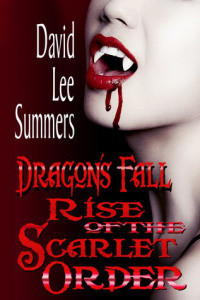 By the same token, you should care a great deal about those subjects you do write about. After all you’re going to spend a lot of time with that subject writing, researching, and editing. If you have a measure of success, the book or story could be with you for some time after it’s written. You should be passionate about the subject.
By the same token, you should care a great deal about those subjects you do write about. After all you’re going to spend a lot of time with that subject writing, researching, and editing. If you have a measure of success, the book or story could be with you for some time after it’s written. You should be passionate about the subject.
I wrote my first vampire story in 2001 and I just sold my most recent vampire story this year, 2016. Vampires were popular when I started and continue to be popular. Even when my vampire novels reach relatively good sales ranks at Amazon, it’s not uncommon to see two or three hundred vampire novels with even better sales ranks. I think this shows both the popularity of the genre and explains why people at science fiction conventions often complain about how saturated the market is with vampire fiction. Of course, this is just another reason why passion is required. If you want to write a bestseller in a particular genre, it’s easiest to do so in a less popular genre than a more popular one!
So, why am I passionate about vampire stories? For me, they touch several themes near and dear to me. Growing up in urban Southern California, I was taught the night is a dangerous place with people lurking in shadows waiting to do me harm. I then went on to discover a love of astronomy and started spending a lot of time outdoors at night. I did learn to be careful and watchful at night, but I also learned that the night can be quiet and peaceful. Writing about vampires is like writing about kindred who are as passionate about the night as I am. I’ll note, the one time someone stole something from me, it was in broad daylight and I saw them coming. While I don’t fear the day, I can’t say it gives me more comfort than the night does.
What’s more, my dad died when I was young, forcing me to confront mortality head on early in life. There is admittedly a certain aspect of wish fulfillment in the idea of becoming a creature that circumvents death. However, living forever would come with costs. Among them, is the question of whether or not immortality is really all it’s cracked up to be and how one deals with hunting others to maintain an immortal existence.
I’m not only passionate about vampires, I’m passionate about history. 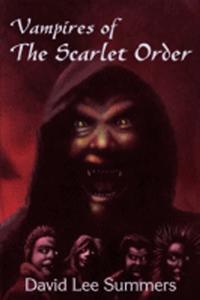 Writing about immortal vampires allows me to take a long view and write about people who get to see different periods of history and watch the world change. Of course, one of the consequences of being a vampire is that you can never really grow close to anyone other than a fellow vampire. Humans just grow old and die too quickly.
Writing about immortal vampires allows me to take a long view and write about people who get to see different periods of history and watch the world change. Of course, one of the consequences of being a vampire is that you can never really grow close to anyone other than a fellow vampire. Humans just grow old and die too quickly.
The website TVTropes.org has a very good page of suggestions for people who are interested in trying their hand at vampire fiction. One thing they discuss is that you should be genre savvy. This allows you to use and subvert tropes with knowledge of how others have approached the subject. Of course, this is another reason to be passionate about anything you wish to write about. If you’re doing it right, you’ll be spending a lot of time reading books and watching movies in the same genre you want to write. If you’re not passionate about it, that exercise will get old real fast.
If you’re passionate about vampires, or even just mildly curious, I hope you’ll spend some time getting to know some of my fictional friends in the following books:
Dragon’s Fall: Rise of the Scarlet Order
Vampires of the Scarlet Order
Blood Sampler
These Vampires Don’t Sparkle


December 10, 2016
Women Marshals of the Old West
Marshal Larissa Seaton is a character who appears in my novel The Brazen Shark from the Clockwork Legion steampunk series. 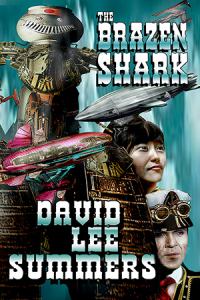 She also appears in some of my short stories set in the same universe, including the story “Fountains of Blood” which will be in the upcoming Straight Outta Tombstone anthology. In my world, President Rutherford B. Hayes appoints her to be a U.S. Marshal after her work recovering a lightning gun from Curly Bill Bresnahan in the novel Lightning Wolves. It’s a fair question to look back at history and ask whether it’s realistic to imagine a woman marshal in 1877.
She also appears in some of my short stories set in the same universe, including the story “Fountains of Blood” which will be in the upcoming Straight Outta Tombstone anthology. In my world, President Rutherford B. Hayes appoints her to be a U.S. Marshal after her work recovering a lightning gun from Curly Bill Bresnahan in the novel Lightning Wolves. It’s a fair question to look back at history and ask whether it’s realistic to imagine a woman marshal in 1877.
As it turns out, Larissa of my fictional world was only appointed marshal seven years before it happened in real life. 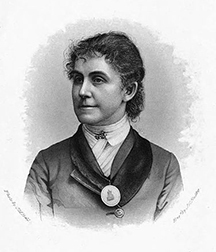 In 1884, John Couzins was appointed marshal for the Eastern district of Missouri and he appointed his daughter Phoebe as one of his deputies. When John Couzins was killed in 1887, President Grover Cleveland appointed Phoebe interim marshal. However, she only held the position for two months before a man was appointed as her full-time replacement. Not only was Phoebe Couzins the first woman to become a U.S. Marshal, she was the first woman in the United States to get a law degree and the first woman to graduate from Washington University in St. Louis. She was an early supporter of both women’s suffrage and the temperance movement. In later years, she actually renounced both and became an active lobbyist for the American Brewers Association.
In 1884, John Couzins was appointed marshal for the Eastern district of Missouri and he appointed his daughter Phoebe as one of his deputies. When John Couzins was killed in 1887, President Grover Cleveland appointed Phoebe interim marshal. However, she only held the position for two months before a man was appointed as her full-time replacement. Not only was Phoebe Couzins the first woman to become a U.S. Marshal, she was the first woman in the United States to get a law degree and the first woman to graduate from Washington University in St. Louis. She was an early supporter of both women’s suffrage and the temperance movement. In later years, she actually renounced both and became an active lobbyist for the American Brewers Association.
There were several notable women deputies marshals with longer careers. 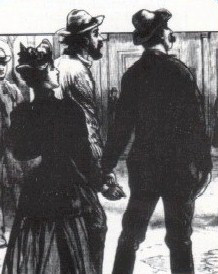 Perhaps the most famous was Ada Carnutt of Oklahoma. In 1893, she arrested nineteen men at the Black and Roger saloon in Oklahoma City for perjury. Shortly before Christmas that same year, she single-handedly arrested two forgers and escorted them to jail. The two heavily armed men supposedly scoffed at being arrested by an unarmed woman, but she pointed to the crowd around and told them she was willing to deputize every one of them to help her. Newspapers of the day noted that after the arrest she went back to her favorite hobby: china painting.
Perhaps the most famous was Ada Carnutt of Oklahoma. In 1893, she arrested nineteen men at the Black and Roger saloon in Oklahoma City for perjury. Shortly before Christmas that same year, she single-handedly arrested two forgers and escorted them to jail. The two heavily armed men supposedly scoffed at being arrested by an unarmed woman, but she pointed to the crowd around and told them she was willing to deputize every one of them to help her. Newspapers of the day noted that after the arrest she went back to her favorite hobby: china painting.
Even before Ada Carnutt, Mrs. F.M. Miller was making a name for herself as a deputy marshal in Paris, Texas. Unlike Ada Carnutt, Mrs. Miller had no problem carrying weapons. According to the November 6, 1891 issue of the Fort Smith Elevator, “The woman carries a pistol buckled around her and has a Winchester strapped to her saddle. She is an expert shot and a superb horsewoman, and brave to the verge of recklessness.” The article also noted that she was a “charming brunette” and wore a sombrero.
So, while true Larissa Seaton would have been the first woman U.S. Marshal in history if she existed, it wouldn’t be long before more brave women would stand alongside her. You can find Marshal Larissa in the following books:
Owl Dance
Lightning Wolves
The Brazen Shark
Lost Trails 2: Forgotten Tails of the Weird West
Den of Antiquity


December 5, 2016
Twisting History
This month has started off with some good news. I have official word that my story “Fountains of Blood” has been accepted for an anthology called Straight Outta Tombstone tentatively scheduled to appear in summer 2017 from Baen Books. Editor David Boop invited me to submit to the anthology a little over a year ago.
My story idea came quickly and I was inspired by a tombstone in the cemetery behind my house. No one’s buried underneath this tombstone. Rather it’s a memorial to a former cavalryman, governor of Texas, and attorney named Albert Jennings Fountain who disappeared near White Sands along with his son Henry on February 1, 1896. Among other things, Fountain operated the Fountain Opera House in Mesilla, New Mexico. Although that building no longer stands, his family rebuilt the building in 1905 as the Fountain Theater, which now shows films selected by the Mesilla Valley Film Society. As it tuns out, for a time they used stationary with a letterhead I designed for them, giving me a thread of connection back to Fountain himself.
Perhaps Fountain’s most famous client as an attorney was Billy the Kid. Most sources cite Billy’s real name as William Henry McCarty. In my Clockwork Legion novels, William McCarty’s life path is changed when he encounters Ramon Morales and Fatemeh Karimi. Instead of getting caught up in an ugly feud known as the Lincoln County War, McCarty becomes one of the Owl Riders, helping to defend the United States against the Russians.
Back in our timeline, after defending Billy the Kid, Fountain would go on to launch an investigation into the Lincoln County War. He was on his way home from Lincoln County when he and his son disappeared. In The Brazen Shark, Fountain still defends Billy. This time it’s not for murder, but for helping his friends Ramon and Fatemeh evade soldiers so they could understand why the Russians were invading the United States in the first place. In the Clockwork Legion series, Billy doesn’t die at twenty-one, and Fountain hires him as a bodyguard for his fateful trip. The problem is, even Billy the Kid can’t stand up to the forces out to stop Albert J. Fountain.
After getting ambushed near White Sands and left for dead, Billy awakens and goes for help. After the long journey, he seeks solace from a “soiled dove” in Las Cruces named Marcella who turns out to know more than he would have suspected and provides Billy with essential clues about the disappearance. Those familiar with my books may recognize Marcella from Vampires of the Scarlet Order.
Of course, my short story stands alone and you will be able to read it without being familiar with my novels. However, for readers who want the fun of seeing the connections and how I’ve bent and twisted history in both universes, I recommend starting with the first books in each series Owl Dance and Dragon’s Fall: Rise of the Scarlet Order. Of course, I’d love it if you would keep right on reading all the books in the two series. That would keep you busy for the months waiting for the new anthology. I hear the author list is pretty amazing and hope I can share the full table of contents soon.


December 3, 2016
The Threepenny Opera
About a week ago, I introduced my youngest daughter to one of my favorite musicals: The Threepenny Opera by Bertolt Brecht and Kurt Weill. It tells the story of Mack the Knife, a thief in Victorian London who marries Polly, daughter of Jonathan Jeremiah Peachum, who controls the city’s beggars. Peachum goes to the police for help and discovers that Mack is protected by the Chief of Police. 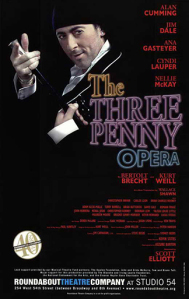 Even so, the Chief of Police has a price and agrees to hunt Mack. Mack flees into the arms of his longtime lover, a prostitute named Jenny. This really only scratches the surface of the play’s story. A lot goes on in a very compact narrative.
Even so, the Chief of Police has a price and agrees to hunt Mack. Mack flees into the arms of his longtime lover, a prostitute named Jenny. This really only scratches the surface of the play’s story. A lot goes on in a very compact narrative.
The play was written in 1928 in Germany as Nazis and communists were vying for control of the Weimar Republic. Brecht was a communist and adapted an English play called The Beggar’s Opera into a critique of capitalism. Whenever a character in The Threepenny Opera has a choice, they will always take the one that will bring them the most money or the most personal pleasure, regardless of what it means for those around them. Being a little vague to avoid spoilers, the ending calls up a deliberate deus ex machina that encourages the audience to realize that real life would give no happy ending for characters that behave this way. It also challenges the audience to ask that if it related to the thieves, beggars, and the prostitutes of the story, they should be careful about treating them as sub-human worthy of no sympathy. I believe the lessons of the play are as valuable and relevant today in the United States as they were in 1928 Weimar Germany.
As it turns out, members of the German Communist Party were among Brecht’s harshest critics at the time the play was released. They wanted the play to include a depiction of the proletariat uprising against the bourgeoisie. I suspect it’s precisely because the play didn’t go this direction that it remains relevant today.
The play has been translated into English multiple times with varying degrees of success. The version represented by the poster at the top of the post was translated by Wallace Shawn, famous as Vizzini in The Princess Bride and starred Alan Cumming as Mack and Cyndi Lauper as Jenny. Unfortunately, Shawn’s translation hasn’t been published, nor was there a cast recording of the show. Fortunately, plenty of other recordings exist including the Mannheim and Willet translation of the 1970s, which features Raul Julia as Mack.
As far as I know, the musical has only been made into a movie three times. 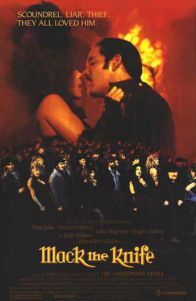 Probably the most famous and widely available is the 1931 version. Among the high points, Kurt Weill’s wife, Lotte Lenya reprises her role as the original Jenny in this early version. Unfortunately, this version drops many songs and changes the play’s ending. I’ve never seen the 1960’s version, but haven’t been able to find a recommendation from a fan. My personal favorite is the 1989 film Mack the Knife starring Raul Julia as Mack, Richard Harris as Peachum, Julie Walters (best known as Molly Weasley in the Harry Potter films) as Mrs. Peachum, and Roger Daltry as the street singer. This version is still quite flawed. It also drops songs, is very dark and muddy looking, and has several unnecessary dance numbers. Despite all that, it seems to capture the essence of the play better than the 1931 version. Sadly, the movie was only released on VHS and no DVD version has appeared.
Probably the most famous and widely available is the 1931 version. Among the high points, Kurt Weill’s wife, Lotte Lenya reprises her role as the original Jenny in this early version. Unfortunately, this version drops many songs and changes the play’s ending. I’ve never seen the 1960’s version, but haven’t been able to find a recommendation from a fan. My personal favorite is the 1989 film Mack the Knife starring Raul Julia as Mack, Richard Harris as Peachum, Julie Walters (best known as Molly Weasley in the Harry Potter films) as Mrs. Peachum, and Roger Daltry as the street singer. This version is still quite flawed. It also drops songs, is very dark and muddy looking, and has several unnecessary dance numbers. Despite all that, it seems to capture the essence of the play better than the 1931 version. Sadly, the movie was only released on VHS and no DVD version has appeared.
As it turns out, my novel The Pirates of Sufiro takes some inspiration from The Threepenny Opera. Captain Firebrandt’s portrayal as the stylish pirate captain, owes a lot to Mack the Knife, who is called Captain Macheath to his face. Also, Firebrandt’s lover Suki is named for Sukey Tawdry, one of Mack’s lovers in the play. The Pirates of Sufiro is available for free at Amazon and Barnes and Noble. My preferred edition of the ebook is available as a PDF directly from my publisher.


November 28, 2016
High Octane Racing
When I was a kid, cartoons about racing were a thing. Two cartoons of note were Speed Racer and Wacky Races. The former was the American translation of the anime Mach GoGoGo! which told the story of Go Mifune who entered races around the world in his car loaded up with gadgets, such as powerful pogo sticks that would propel the car over obstacles, rotary saws to just cut through obstacles, and special traction belts to allow the car to climb steep roads. Wacky Races was an American cartoon inspired by the 1965 film, The Great Race. It imagined a group of colorful characters racing around the world in equally colorful cars, often containing gadgets a bit like Go Mifune’s Mach 5. One of the racers, evil Dick Dastardly and his dog Muttley would routinely try to thwart the other racers who included the beautiful Penelope Pitstop and inventor Pat Pending.
This past summer, I discovered that DC comics started a comics line that featured ramped-up versions of classic Hanna-Barbara cartoons. I wrote about Wacky Raceland, based on Wacky Races and Scooby Apocalypse based on Scooby-Doo, Where Are You? 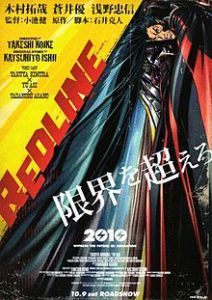 In Wacky Raceland, the racers drive their AI-enhanced cars through a post-apocalyptic wasteland under the watchful eye of a disembodied announcer who has promised some kind of reward. We still have Dick Dastardly and Penelope Pitstop. In this new version, Muttley is semi-intelligent because of his own AI enhancements. Professor Pat Pending seems to have a set of secrets connected to the apocalypse. I’ve been following and enjoying the comic and I gather it ends with issue six in about a week. When my daughter read the first issue, she said the story reminded her of a racing anime—no, not Mach GoGoGo!—but a newer one called Redline.
In Wacky Raceland, the racers drive their AI-enhanced cars through a post-apocalyptic wasteland under the watchful eye of a disembodied announcer who has promised some kind of reward. We still have Dick Dastardly and Penelope Pitstop. In this new version, Muttley is semi-intelligent because of his own AI enhancements. Professor Pat Pending seems to have a set of secrets connected to the apocalypse. I’ve been following and enjoying the comic and I gather it ends with issue six in about a week. When my daughter read the first issue, she said the story reminded her of a racing anime—no, not Mach GoGoGo!—but a newer one called Redline.
I finally had the chance to watch Redline this past week. It was actually a lot of fun. It’s about racers competing on different tracks around the galaxy. The hero is Sweet JP who races a vintage yellow Mustang with an enhanced engine that gets a burst of speed by dropping nitro pellets into the fuel tank. His rival and love interest is Sonashee, known as “Cherry Boy Hunter”. She has an amphibious car armed with missiles. The movie opens with a race known as the “Yellowline.” Sweet JP’s mechanic is in deep with the mob and just as it looks like Sweet JP is going to win the race, the mechanic sets off a bomb in Sweet JP’s car, causing him to crash. Sonashee zooms past him and wins.
The next race is the titular Redline which is scheduled to be held on a heavily militarized planet where the racers are not welcome. Because some of the racers who qualified don’t want to risk their necks, Sweet JP is offered a spot in the race. The anime features some neat cars, some interesting and rugged settings, and great aliens. More than once, I was reminded of the pod-racing scenes in Star Wars but the art and voice acting in the anime conveyed more thrills.
One thing that made the movie Redline interesting is that in this modern era of CGI animation, it’s all hand-drawn. The movie is really beautiful to watch. The art style reminded me more of the European comic art you might find in a magazine like Heavy Metal than most anime. To be honest, the story itself wasn’t much to talk about. It’s a simple love story tied to the story of a race. Sweet JP and Sonashee are attracted to each other but are rivals. Sweet JP’s friends are connected to the mob adding complications. It’s the kind of stuff you may have seen in lots of other stories about races and competitions.
Despite the familiarity, there are some interesting science fictional elements added late in the story. The militarized planet has some creepy bioweapons up its sleeve plus the holographic imagery of their control center is well realized. Many of the aliens in the movie are also interesting and use the freedom of animation to take us beyond humans in suits.
I’m looking forward to seeing how the Wacky Raceland comic resolves, but I’m especially grateful that the comic gave me an excuse to go back to the racing cartoons of my youth and discover the movie Redline.


November 26, 2016
Acting Out a Scam
No one has ever accused me of being a financial analyst, but I once played one on the television series, Unsolved Mysteries. Here’s a somewhat blurry screenshot from the episode. I’m the tall, happy fellow in the yellow hard hat.
Back in my senior year at New Mexico Tech, while working on my physics degree, I had a few elective hours available and took a class in musical theater. We presented the Lerner and Loewe play, Brigadoon. The musical director was Mike Iaturo, who I gather played accordion on Broadway for Fiddler on the Roof. The play’s director was Carolyn Abbey. Carolyn’s husband, Mike, is the bearded fellow in the photo above.
After graduating, I remained at New Mexico Tech to work on my master’s degree in physics. I also joined a community theater group run by Carolyn and we put on a set of one-act plays collectively entitled The God’s Honest. Working on these plays was good experience for collaborating with editors and artists as a writer and publisher. I learned to listen, be flexible, and take criticism. The collaborative nature of plays taught me the freedom to change lines so they worked best for the scene as played. It helped me to avoid falling so much in love with my own words that I could never change them.
In the fall of 1989, Carolyn called me to say the television series Unsolved Mysteries was holding auditions in Socorro for a segment they would be filming. I went to the hotel where they were holding the auditions and stood in line for a while. The casting director looked me up and down asked if I had a suit and was willing to shave for the part. I answered “yes” to both questions and she called the next person. Since she didn’t ask me to do anything else, I was certain she wasn’t interested. The casting director surprised me a day later when she called up to say I’d been cast as one of the financial analysts who investigated a gold mine scam a few years before in New Mexico.
It was an interesting experience to see behind the scenes of the making of a television series. As I recall, I woke up at 5 in the morning, dressed in my suit and went to the hotel where I auditioned. I met the other actors and extras who were hired and they drove us to a mine just north of Socorro in the small town of Escondida. We were there until about 6pm. All of the extras playing financial analysts hung out together. From time to time, we were called out to play in a scene. When we were not acting, we had access to a trailer full of stuff to eat. As a graduate student, this was like a dream come true.
The segment featured Maurice “Ed” Barbara, who convinced people to invest in his fake cold mine near Truth or Consequences, New Mexico. Among the people he conned was famed attorney Melvin Belli, who played the Friendly Angel in the Star Trek episode, “And the Children Shall Lead.”
The episode finally aired on December 13, 1989. It was episode number 40, which was part of the second season. Here’s the part of the episode I was in. As you can see, twelve hours of filming was condensed down into about two minutes. I have to admit, it’s something of a thrill to have my actions narrated by Robert Stack.
I gather there was a follow up in episode 64, but unfortunately, I never saw that. If anyone has ever heard what happened to Ed Barbara, I’d be interested in hearing the end of the story. At the end of the episode, they said he had fled to Canada.
Hope my readers in the United States are having a good Thanksgiving weekend and staying away from scams on this busy shopping weekend!



